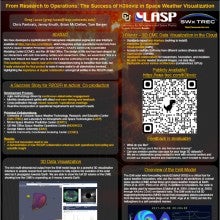From Research to Operations: The Success of H3lioViz in Space Weather Visualization
Greg
Lucas
LASP / SWx TREC
Poster
Creating advanced tools for operational space weather forecasting relies on a robust Research to Operations to Research (R2O2R) pipeline. The H3lioViz project has focused on enhancing the interface between tool developers, researchers, and operators to foster more productive collaboration. This presentation illustrates a successful, collaborative framework for developing a production-class visualization capability for space weather forecasting.
H3lioViz, found at https://swx-trec.com/h3lioviz, integrates a sophisticated 3D heliosphere visualization engine with an easy-to-use interface and is available from any browser. It enables the interactive exploration of operational space weather model runs from NOAA’s Space Weather Prediction Center (SWPC), NASA's Community Coordinated Modeling Center (CCMC), and the UK Met Office.
To maximize user interaction and experimentation, the project eliminated the need for software installation and data transfers by containerizing the tool and leveraging a cloud environment, in this case AWS. This robust, transportable system streamlined collaboration by enabling multiple parallel sessions, worldwide users, and the ability to quickly point to new data cubes with minimal latency and high uptime. Forecasters and researchers are able to use the tool in their own time, allowing the developers to take a back seat to the subject matter experts who drive the design with thoughtful, informed feedback.
Our experience highlights the importance of strong collaboration, effective communication, and innovative deployment strategies in advancing operational space weather forecasting tools. The success of our visualization capability and the collaborative framework supporting it underscores the value of the R2O2R process in enhancing operational efficacy and scientific understanding.
H3lioViz, found at https://swx-trec.com/h3lioviz, integrates a sophisticated 3D heliosphere visualization engine with an easy-to-use interface and is available from any browser. It enables the interactive exploration of operational space weather model runs from NOAA’s Space Weather Prediction Center (SWPC), NASA's Community Coordinated Modeling Center (CCMC), and the UK Met Office.
To maximize user interaction and experimentation, the project eliminated the need for software installation and data transfers by containerizing the tool and leveraging a cloud environment, in this case AWS. This robust, transportable system streamlined collaboration by enabling multiple parallel sessions, worldwide users, and the ability to quickly point to new data cubes with minimal latency and high uptime. Forecasters and researchers are able to use the tool in their own time, allowing the developers to take a back seat to the subject matter experts who drive the design with thoughtful, informed feedback.
Our experience highlights the importance of strong collaboration, effective communication, and innovative deployment strategies in advancing operational space weather forecasting tools. The success of our visualization capability and the collaborative framework supporting it underscores the value of the R2O2R process in enhancing operational efficacy and scientific understanding.

Poster PDF
Poster category
Solar and Interplanetary Research and Applications
Meeting homepage